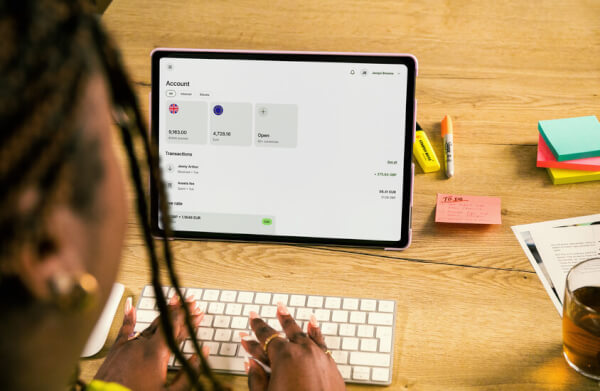How to Get Paid by International Clients - Guide for UK Freelancers
Getting paid by international clients as a freelancer can be tricky. Check out our guide to learn the best ways to get paid from abroad without losing on fees.

Freshbooks is cloud-based accounting software, which allows entrepreneurs and small businesses to track their accounts, and manage every stage of invoicing. You can use Freshbooks to create estimates for work, track time and expenses, issue invoices and even to receive some payments. There are both free and paid versions available. The team at Freshbooks say 97% of small businesses who have used them would recommend the product - and with some free features on offer, you might want to try it and see if it’s right for you.¹
If you’re thinking about using Freshbooks to manage your accounting, you’ll need to know how it works. Here’s the lowdown.
Freshbooks has a lot of neat features. But to know whether it’s right for you, or not, the most important thing to understand is whether it meets your needs for invoicing and receiving payments. After all, if you can’t get paid for your work using this tool, then it’s probably not much use. So, let’s concentrate on how you can bill clients, and get your hands on your earnings when you work with Freshbooks.
Before you start to think about using Freshbooks, you need to know that there are two different versions out there, with different functionality. When it comes to payments, the new version of Freshbooks allows you to integrate Freshbook payments, and Stripe, while the classic version has other options, too.² If you’re based in the US or Canada, you might find that the new version works well for you. Elsewhere in the world, the classic version offers a greater range of payment options for most people.
If you choose to use Freshbooks as your accounting tool, you can get paid in a few different ways:
Creating an invoice in Freshbooks is easy. The system is intuitive, and allows you to customise your invoice with a logo, and even change the colours used.⁴
You have some options to get an electronic payment, using tools integrated with Freshbooks. But they might not always suit your needs. However, wherever you are, and regardless of where your customer is, you can still create a Freshbooks invoice, send it by email, and have your customer pay you directly using the bank details you provide there.³ You can then mark it as paid when the funds come through within Freshbooks to keep your records straight.
If you're based in the US or Canada you can also enable credit card payments to allow your customers to pay direct from the invoice. Elsewhere you can use Stripe or PayPal to receive online payments.⁵
US and Canadian registered Freshbooks accounts come with the automatic ability
to accept payments online.⁵ When you create an invoice and send it over to your client, you just activate the ‘pay by card’ function, and your customer can pay directly from the invoice in just a few clicks.6 At the moment, although you can charge customers based outside of the US or Canada, you will have to bill them in USD or CAD.7 A client elsewhere can then pay using their credit card which might be issued in another currency - however they’ll likely be charged conversion fees to do so.
Depending on the version of Freshbooks you use, there are other neat features, such as turning on automatic reminders, and adding late fees. That means that the tool will automatically send reminder emails if the customer doesn’t pay, and can add incremental late fees if you choose to charge them.7
This Freshbooks payment product allows you to accept payment from clients in-person, using a card reader.8 That could be really useful, for example, if you’re a small business owner trading face to face. Maybe you’re an artist selling at craft fairs, or a landscaper working in your neighbourhood. This could make it easy to take payment there and then, from customers you’re physically present with. It is, however, powered through WePay, which requires that users are based in the US.8 That means it’s not much use if you’re based in Canada, the UK, Europe, or elsewhere in the world.
However, if you’re in the US, you can order the card reader to allow you to accept ‘in person’ payment from clients. Keep an eye on the product for further updates which might bring this functionality to the rest of the world on the new Freshbooks platform.
When you set up your profile on Freshbooks, you’ll also need to upload all of your payment details if you ever want to use integrated electronic payments. You simply need to go to the settings tab in your account and fill in the details. You’re asked to choose a secure password, which is used if you need to do anything like refund a client after they’ve paid a bill using their card.
The new version of Freshbooks is really optimised for people who want to charge using a credit card. However, if you’re using the platform to create invoices only, and will be asking for payment from outside of their system, then you can still add your bank details to the invoice. You’ll have to add details for whichever payment method you might choose - so that could be bank details, including BIC/SWIFT if relevant, and your bank account number, or your PayPal email address for example.
If you’re asking a client based outside of your country, to send you money, it’s worth bearing in mind the fees for sending internationally will likely be deducted from the payment before the money reaches you. This means that you could end up with less money than you think, especially if currency conversion is involved. We’ll talk a bit more about how best to deal with and minimise these fees later - to help you make sure you see as much of your earnings as possible.
When it comes to getting hold of your earnings through Freshbooks you have a couple of choices. Your options are: 5
If you’re in the US or Canada you can use the Freshbooks integrated online card payment system. This means that once you have connected your bank account to your Freshbooks account, any money you bill this way is released to your account the next business day. It can, however, take an additional 2-5 days to reach your account because of admin and security checks along the way.10
If you invoice over $10,000 in a given week, anything above that amount is held by Freshbooks as a reserve. This is designed to be a pot of money held back in case of dispute or, in the event you have to refund. The reserve is then released after 7 days and you can access it.10
If you can’t use the integrated card payment method - for example, if you’re outside the US or Canada, then activating Stripe can be a good idea. You don’t need a merchant account and can get started very quickly. Because it integrates seamlessly with Freshbooks, your customers won’t get redirected to a new site. Once you’ve activated Stripe payments on an invoice and sent it, your customer simply clicks through to pay online directly from the invoice.11
Of course, you can use Freshbooks to generate invoices, and accept payments outside of their platform. If you don’t want to bill your clients by credit card, then you can include your US bank details on the invoice, and have clients pay you that way. Direct deposits to bank accounts in the US are sometimes called ACH (Automated Clearing House) payments.2 You can then keep everything synced by marking the invoice as paid manually, in Freshbooks.
And if you don’t have a US bank account, you could generate local bank details with a Wise borderless account, and still use this transfer method. This could very well be the option which incurs the lowest fees if you’re based outside of the US but working with clients who are in America and will be paying in dollars. More on the Wise borderless account account later.
If you’re using Freshbooks to create invoices in USD, but want to be paid by bank transfer to an account held in a different currency, you can do that manually in both the new and classic Freshbook versions. You’ll have to put all your bank account details on the invoice and have your client make an international bank transfer to your account. That means the money will leave their USD account, and be converted to the currency of your account en route.
International bank transfers can be handy if you need to move your money to a bank account held in a currency other than USD. However, in this case, you’ll have to consider the exchange rate that’s used, and any additional fees that could be added along the way.
Exchange rates and fees used in international bank transfers, in many cases, might be set by partner banks. The rate used often isn’t transparent - and could well be pretty poor, so you end up losing out.
And it’s not only the exchange rate used that can cause a headache. If your money is moving across borders via international bank transfer, the fees added can be painful, as usually your money will be transferred via the SWIFT network. While SWIFT transfers are safe, and commonly used, they often mean extra flat fees are charged, by anywhere from 1 to 3 intermediary banks. That means you generally end up with far less in your pocket than you should.
A good way around all of these issues is to open a Wise multi-currency borderless account. You can get paid using local bank details in the UK, Europe, Australia and the US, so if you have a dollar payment to claim, use the local US bank details provided as part of your borderless account, to receive the payment. If you need to then move your cash to an account in a different currency, using Wise you’ll get the real exchange rate - set out clearly, and without markups. More on that later, though.
PayPal is a common choice for freelancers. If you have an existing PayPal account and use Freshbooks Classic, you can integrate your PayPal account with the platform, so your customers can pay you directly.5 You just have to turn on the setting for PayPal payments in your account settings.
If you’re on the new Freshbooks platform, PayPal doesn’t integrate just yet.12 However, you can ask for your earnings to be sent via PayPal, simply by including your PayPal account details on your invoice.
As you’ll know if you use PayPal, there may be charges, including additional fees for moving your money if it’s going across borders, or if there’s a currency conversion involved.
If you’re already in the US or Canada, you can connect your bank account to your Freshbooks account, and take payment online from your clients. The payment is then transferred directly to your bank account daily - although there may be up to 5 days delay before the released payment hits your bank account.¹⁰
If you’re in the US or Canada and using integrated online card payments, there are charges to pay. There’s no monthly fee or set up charge, but you’ll pay 2.9% + $0.30 on all card transactions, with the exception of American Express, which is 3.5% + $0.30.13
You can charge clients based in anywhere in the world, and have them pay online - but you must bill them in USD or CAD.13 That means the customer will likely find there are fees from their issuing bank to pay for making a payment in a currency different to their own.
If you use Stripe, the charges depend on where in the world you are. It could also make a difference whether the card you’re using is issued in the same country as the one you’re billing in. So for example, if you’re using Stripe in the UK, you’re charged 1.4% of the total, plus a GBP 0.20 charge if you’re taking payments using a European card. The fee then jumps to 2.9% plus that GBP 0.20 charge if the card being charged is from outside of Europe.14
If you use Stripe in Canada, you have a flat charge of 2.9% plus CAD 0.30, for all transactions.15
There are discounts and packages available for enterprise clients using Stripe, which could be a better option if you bill large amounts. To make sure you know how much money you’ll eventually get in your pocket when using Stripe, check out the local details for your area online.
Wherever you are in the world, you might find that you sometimes need to create an invoice in USD. Perhaps you’re working with a customer based in the US, for example, and have agreed a fee based on their local currency.
So how do you manage this when it comes to billing?
You could simply put your local bank details onto the invoice, and have the client make an international transfer. Or you could use PayPal, and have them convert the payment into your local currency. However, PayPal, banks, and most money transfer services add charges to any transfer which crosses international borders, which means they could potentially be a poor choice.
Not only are fees often hard to calculate in advance when you choose an international transfer with a bank or PayPal, the exchange rate isn’t always that great either. As a freelancer, that can severely reduce your ultimate take-home pay.
You can check the current exchange rates easily enough online with an online currency converter. However, the rates applied to international transfers are often not transparent. Banks and money transfer services sometimes say that they’ll move your money for free, but of course, they have to make money somehow. This could mean you lose an extra 4-5%, simply because they use a poor rate on the conversion.
So, if you’re being paid in USD, for an invoice you issue using Freshbooks, most likely the cheapest option to get your cash is to use an ACH transfer to a US based bank account. That means there are no charges associated with international transfers.
I know what you’re thinking: how does that work if you live outside of the US?
You’ll be pleased to hear that you can be paid using local US bank details, even if you don’t hold a USD bank account, if you open a Wise borderless multi-currency account. The borderless account lets you live in one country, but get paid locally in another. You can be paid with local bank details in the EU, the US, the UK and Australia, and avoid the fees associated with payments made across borders.
For example, David is a freelancer living in France. He’s billing a customer for a project paid in US$ through Freshbooks. However, David’s usual bank account is held in euros - and he doesn’t have a local USD bank account. He registers with Wise, and after being verified for a borderless account, activates USD on his account and generates local US bank details. David adds these local US bank details to his Freshbooks invoice to get his money using an ACH payment. Once he has his money safely in his borderless account, David can either keep it in USD or move it out of the borderless account to his usual euro bank account, using a low-fee transfer from Wise.
If you invoice clients around the world as part of your work as a freelancer or small business owner, it could be time you tried a new way of managing your finances.
The Wise borderless account is built for international people. It’s the new alternative to old-fashioned banking and allows your money to be as flexible as you are.
Create a multi-currency borderless account and manage over 40 currencies at once in a single account. Get paid like a local in the US, the UK, the EU and Australia. And, from the beginning of 2018, get your hands on a debit card that’s linked to your account, too. What’s not to love?
Check out which countries are eligible for a borderless account on the Wise Borderless account page.
Freshbooks is a great tool for small businesses and individuals, who want to make it easier to create invoices and manage their accounts. However, if you hold a bank account in one currency, and bill in another, then you could be losing out because of unfair charges and hidden fees on international money transfers. You have alternatives. Ditch your regular bank transfers, and check out Wise, to make sure you get the best deal available. With the right tools in place, the sky’s the limit for your business.
Sources:
1.https://www.freshbooks.com/ (September 25 2018)
2.https://www.freshbooks.com/support/which-payment-gateway-should-i-choose#FBPay (September 25 2018)018)
3.https://www.freshbooks.com/support/makinginvoices (September 25 2018)
4.https://www.freshbooks.com/support/settings-colors-and-logos (September 25 2018))
5.https://www.freshbooks.com/support/which-payment-gateway-should-i-choose (September 25 2018)
6.https://www.freshbooks.com/support/how-do-i-receive-online-payments (September 25 2018)
7.https://www.freshbooks.com/support/can-i-customize-my-invoices#currency (September 25 2018)
8.https://www.freshbooks.com/policies/card-reader-terms (September 25 2018)
9.https://www.freshbooks.com/support/quick-start-guide (September 25 2018)
10.https://support.freshbooks.com/hc/en-us/articles/115014259608-Where-is-my-money- (September 25 2018)
11.https://www.freshbooks.com/addons/stripe (September 25 2018)
12.https://support.freshbooks.com/hc/en-us/articles/217544777-How-do-I-accept-Credit-Card-payments-with-FreshBooks-Payments- (September 25 2018)
13.https://www.freshbooks.com/support/what-are-the-transaction-fees-for-freshbooks-payments (September 25 2018)
14.https://stripe.com/gb/pricing (September 25 2018)
15.https://stripe.com/ca/pricing (September 25 2018)
This publication is provided for general information purposes only and is not intended to cover every aspect of the topics with which it deals. It is not intended to amount to advice on which you should rely. You must obtain professional or specialist advice before taking, or refraining from, any action on the basis of the content in this publication. The information in this publication does not constitute legal, tax or other professional advice from TransferWise Limited or its affiliates. Prior results do not guarantee a similar outcome. We make no representations, warranties or guarantees, whether express or implied, that the content in the publication is accurate, complete or up to date.
*Please see terms of use and product availability for your region or visit Wise fees and pricing for the most up to date pricing and fee information.
This publication is provided for general information purposes and does not constitute legal, tax or other professional advice from Wise Payments Limited or its subsidiaries and its affiliates, and it is not intended as a substitute for obtaining advice from a financial advisor or any other professional.
We make no representations, warranties or guarantees, whether expressed or implied, that the content in the publication is accurate, complete or up to date.

Getting paid by international clients as a freelancer can be tricky. Check out our guide to learn the best ways to get paid from abroad without losing on fees.

Self-employment and freelancing makes up around 14% of the employment market in Singapore in June 2020 which accounted for 228,200 individuals running a...

Freelancing and want to know which freelancer platform to choose - read our review of Upwork to help you decide.

There are three ways to withdraw money from Fiverr; the first two methods are provided by Payoneer, while Paypal provides the third method.

work from home jobs. customer service, writer, editing and proofreading, software engineering, web design, product design.

Joining millions of freelancers, but still unsure how much you can expect to earn? Check out our guide to see how much you could earn.